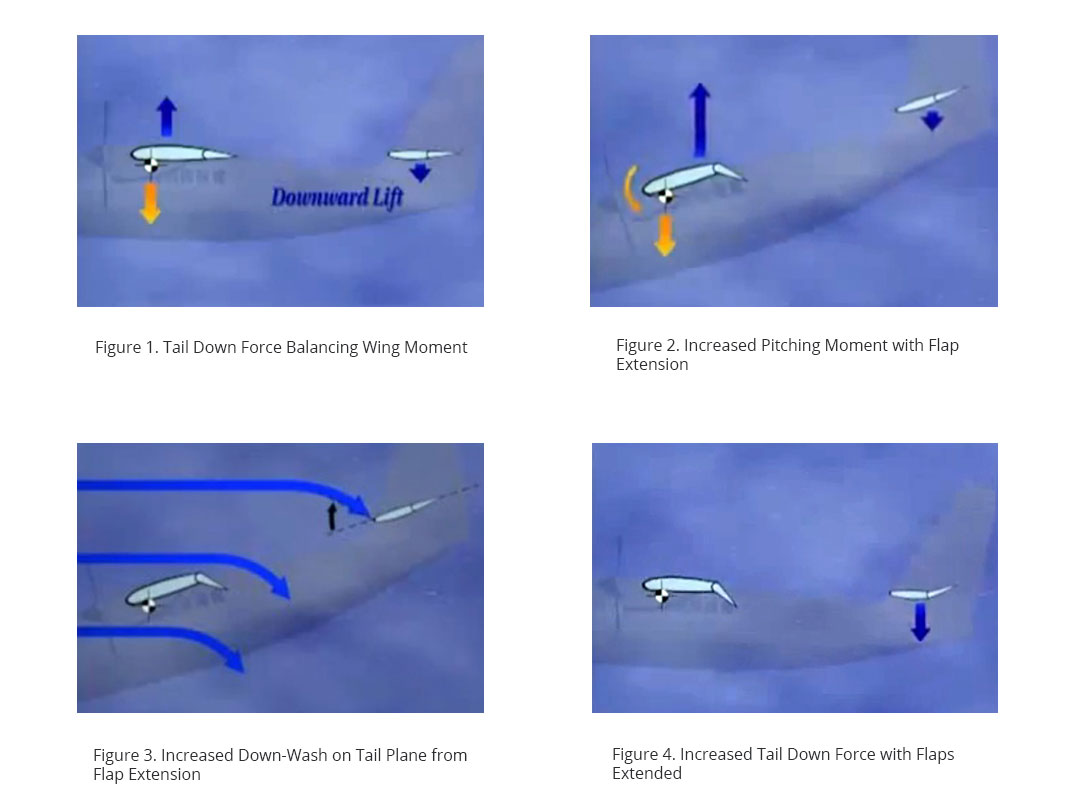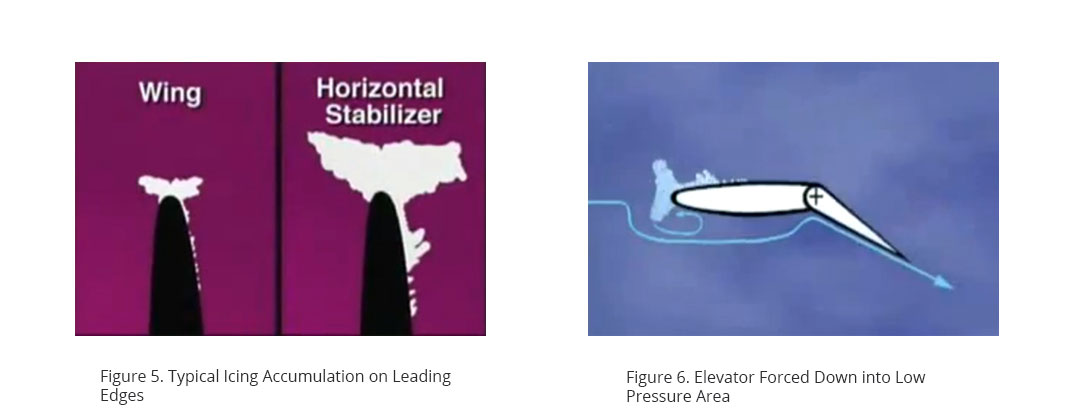Before Reading this Tail Plane Icing Article
A Pilot-to-Pilot Message from APS Flight Training and Standards
Attention Pilots,
There is much controversy concerning the topic that follows. Despite this, we feel safety-conscious pilots should have access to pertinent tail plane icing information whether out of necessity or simple curiosity. However, and this is important, a deep understanding of tail plane icing concepts is needed for pilots as just a limited or cursory understanding of the information that follows could have dire consequences. Although the aerodynamic information below is accurate based on available resources at the time of writing, this information should not be considered a pilot’s primary source of information on the tail plane stall.
All pilots (even those pilots where their model of airplane is listed below) MUST consult with their manufacturer as the primary and official resource to determine:
- If their model is susceptible to the tail plane stall
- The details of the tail plane stall diagnosis for their model of airplane (if applicable)
- If needed, the tail plane stall recovery technique or techniques specific to that model
The following industry opinion is offered for your consideration as a pilot:
Opinion: A recent FAA rulemaking committee recommended the removal of tail plane icing theoretical training from those aircraft types that are not susceptible to tail plane icing. Their stated concern was that a general working knowledge of the subject could lead a crew to do the exact opposite of what is required in a stall.
As a specialized training provider, having trained many thousands of professional pilots in upset recovery training over the past two decades, APS respects and understands the statement above but we do not fully agree with it. In our experience, pilots are mystified by the tailplane icing threat (other than that tail plane icing occurs in icing conditions) and they lack awareness of two primary factors: 1) the very limited list of airplanes it applies to, and 2) the basic aerodynamic factors in diagnosis. In our opinion at APS, leaving a pilot mystified for fear they may not properly apply their knowledge correctly does not address the deficiency. With that said, pilots must THOROUGHLY understand the information that follows, especially the understanding that only a very limited number of airplane models are susceptible to this phenomena and that the airplane’s manufacturer is the primary source of operational information.
The following message will be reiterated through the article that follows: In the vast majority of cases, the main wing stall in both icing and non-icing conditions is a much more likely threat of loss of control in-flight than the tail plane stall.
Sincerely,
Clarke ‘Otter’ McNeace, APS VP Flight Training & Standards
Related Articles:
- Read how the use of APS training saved a crew from airframe icing: Real Life Saves – Surviving an Ice-induced Airplane Upset
- For a detailed description of how Airframe Icing Influences on the Risk of Loss of Control In-flight, see this APS presentation on the subject: APS Briefing: Main Wing Icing and Upset Recovery
- APS UPRT Programs
Tail Plane Stall: Differentiating from a Main Wing Stall

By: Karl “Schlimmer” Schlimm, APS Safety Officer
Advanced Upset Recovery, Aerobatics & Stall/Spin Instructor
Aviation Performance Solutions LLC (APS)
References
- NASA/FAA Tailplane Icing Program: Flight Test Report (Thomas P. Ratvasky)
- Various NTSB Accident Reports
- A Limited Use Reference: NASA Tailplane Icing Video
- Related APS Article: Real Life Saves – Surviving an Ice-induced Airplane Upset
In this article, I’ll explain what an Ice Contaminated Tailplane Stall (ICTS) is, and how to differentiate between an ICTS and a main wing stall. I’ll also explain which aircraft, or which types of aircraft, are most susceptible to an ICTS encounter.
NASA conducted a Tailplane Icing Program (TIP) in the late 90’s in response to an FAA request for further study into the matter. At the time of the study, ice contamination on tailplane surfaces had already been blamed as the primary cause of 19 aircraft accidents resulting in 139 fatalities.
The key to avoiding an ice contaminated tailplane stall hinges on a sound aerodynamic understanding of what can cause it. Any aircraft that has a horizontal stabilizer and is susceptible to ice accumulation is also susceptible to an ICTS. When an aircraft encounters icing conditions, ice can build up on any surface of the aircraft. Modern aircraft employ various measures to battle ice buildup including de-icing boots on the wing, horizontal and vertical stabilizers, and ant-icing systems.
Ice accumulation can disrupt the smooth airflow on the main wing. And no matter where it collects on the aircraft, it can add a tremendous amount of weight. Both of these events can increase the stall speed of the main wing and aggravate stall characteristics. So the pilot must be wary of a main wing stall when ice accumulation is noticed. It is the same icing environment that can lead to an ICTS. Unfortunately the pilot cannot usually see what is happening to the tail surfaces. So it must be assumed that if ice is collecting on the wings, it is also collecting on the tail surfaces. To understand what happens in an ICTS, one must understand how the tailplane works to achieve equilibrium of forces on an aircraft, when the tailplane is operating near its aerodynamic limit (i.e. close to its critical AOA) and how ice accumulation, configuration changes and airspeed and power changes effect the aerodynamic limit of the tailplane.
An aircraft’s center of gravity (where the aircraft pivots) is normally forward of the center of pressure. This produces a natural pitch forward moment of the main wing (Figure 1, below). The horizontal stabilizer is essentially an inverted wing, and provides a stabilizing downward force to achieve equilibrium. As flaps are lowered, the center of pressure moves aft creating a greater pitch forward moment (Figure 2). Also, as flaps are lowered, the downwash from the main wing strikes the horizontal stabilizer at a greater downward angle, creating a greater tailplane angle of attack (Figure 3). So, as flaps are lowered, the pilot must pull back on the yoke bringing the elevator up and increasing the downward force of the horizontal tail (Figure 4). This causes the tail to perform closer to its aerodynamic limit, possibly at time when icing is present on the leading edge of the horizontal stabilizer.

Ice accumulation on the leading edge of the horizontal stabilizer (Figure 5, below) can be much more severe relative to its leading edge radius than on the main wing. Ice buildup on the leading edge of the tail decreases stalling AOA of the tail and limits the amount of tail down force achievable to keep the aircraft in equilibrium, especially as flaps are lowered. The ice on the leading edge produces an airflow separation “bubble” aft of the tailplane leading edge on the underside of the tail (Figure 6). If that low pressure bubble moves aft and behind the hinge point of the elevator as AOA of the tail increases, the elevator surface could be forced (pulled) down abruptly to fill the low pressure void. This would pull the yoke forward. Operating with a forward CG can aggravate the problem due to the increased pitch forward moment of the aircraft causing increased tail down force and tailplane angle of attack.
Flying on autopilot can mask the warning signs that tail plane icing is occurring and a tail plane stall imminent. Specifically, the pilot may not notice tactile feedback cues. Moreover, symptoms may not be noticed in cruise flight since the horizontal stabilizer is not working anywhere near its performance limit. The pilot may actually not notice any problem until flaps are lowered close to the ground.
A typical progression of symptoms might be:
- A lightening in the controls, particularly in the forward direction, which can lead to a PIO (pilot induced oscillation) since it is far easier to push forward then to pull back on the yoke.
- The aircraft may become difficult to trim.
- Also, buffeting may be felt through the control column as the elevator begins to flutter due to airflow separation and reattachment below it. This would not be the same as airframe buffet due to a main wing stall. The pilot must be able to differentiate between airframe buffet present typically just before or during a main wing stall, which can be felt through the seat, and control buffet present typically just before a tail plane stall.
- As the situation worsens, the yoke will start wanting to come forward out of the pilot’s hands. Forward pulses may occur, and eventually the yoke may be snatched forward aggressively to the stop as the elevator is pulled aggressively downward into the low pressure separated airflow region on the underside of the tailplane. This will cause a pronounced pitch down. Control forces can easily reach or exceed 170 pounds, requiring two pilots to pull the elevator controls back. Pilots have noted a lightening in the seat or even being pulled out of the seat. This situation may not be recoverable at low altitude.
NASA identified three paths which could lead to a tail plane stall in the presence of tail plane icing. They are:
- Increasing Flaps: Increasing flaps causes increased downwash over the tailplane thus making the tail plane AOA more negative. Yoke buffet indicates separation and reattachment of airflow on the underside of the tailplane. This makes it difficult to keep the aircraft in trim. Symptoms are often encountered immediately after flaps are lowered to near full or full extension.
- Increasing Airspeed: With flaps full, increasing airspeed while maintaining power can increase negative AOA further and increase yoke buffet.
- Increasing Power: Increasing power while maintaining speed can also induce a tailplane stall, especially with full flaps. As power increased, the pilot will pull back on the yoke to maintain airspeed, bringing the elevator up which further increases negative AOA of the tail plane.
Once a tailplane stall occurs, nose down pitch rate can increase rapidly. Altitude loss can easily reach a few hundred feet even if control is regained. This can be disastrous if on final approach. Avoid full extension of flaps. And if any flaps are used, it is recommended to extend them at a safe altitude that would allow for successful recovery if a tailplane stall occurs. Make pitch changes slowly, particularly nose down movements. If the airplane has a deicing system, activate the system several times to attempt to dislodge the ice. Land with reduced flaps if conditions permit.
Note to Pilots: In the vast majority of cases, the main wing stall in both icing and non-icing conditions is a much more likely threat of loss of control in-flight than the tail plane stall.
ICTS Recovery Procedure: While the symptoms of a tailplane stall can be similar to a main wing stall (e.g. nose pitch down), the recovery procedure can be dramatically different. The procedure for recovering from a tailplane stall is to:
- Pull back on Yoke
- Reduce Flaps to last setting
- Reduce Power (on some aircraft); or at least be judicious with power.
If the pilot determines that there is control buffet or lightening of the controls, and has difficulty trimming the aircraft, or is experiencing PIO, he should immediately pull back on the yoke to counteract an un-commanded forward movement of the yoke, reduce flaps to previous setting and be cautious with power. Pulling the yoke back and retracting the flaps to the previous setting are universal. And NASA determined that it is often wise to be very judicious with power since power increases can make the tailplane have to work much harder. Also, it is important to maintain airspeed precisely.
This recovery is of course opposite compared to a main wing stall recovery which would be to relax back pressure or push yoke forward depending on aircraft, configuration and trim, and to add power. And a pilot not acutely aware of the oftentimes subtle differences between a main wing stall and a tail plane stall may apply the wrong recovery technique in an altitude critical environment with potentially disastrous results.
Another way to differentiate between the two stalls is configuration and speed. If flaps are lowered at the high speed range of flap extension and control buffet occurs, there is a good chance that tail plane icing exists. The higher the airspeed when flaps are extended, the more susceptible the aircraft is to a tailplane stall.
Aircraft Susceptibility to ICTS: The following are traits of types of aircraft that are susceptible aircraft common characteristics:
- Examples of aircraft known to be susceptible tailplane icing include the Cessna Caravan, Pilatus PC-12, Beechjet 400 and Mitsubishi MU-300 Diamond, and King Air 200, 300, 350 (T Tail). All pilots, even for pilots of aircraft models listed here, must consult with the manufacturer of their airplane concerning type-specific tail plane icing susceptibility, diagnosis, countermeasures and, if applicable, recovery techniques.
- Aircraft with unpowered controls (i.e. aircraft that rely on aerodynamic forces to keep stick forces neutral). These aircraft have a fixed horizontal stabilizer leading edge with a trim tab on moveable elevator. Large aircraft with hydraulic controls are less susceptible to ICTS. However, for these aircraft, the tactile cues of an impending tail stall will be less noticeable as well. The pilot needs to be more perceptive of subtle cues such as unusual trim settings and PIOs.
- Flaps w/ large deflection causing greater downwash on the horizontal stabilizer resulting in greater tailplane AOA. Many operators are prohibited from lowering flaps while holding in known icing conditions.
- Aircraft that use de-icing boots instead of an anti-icing system.
- Turboprop aircraft are generally more susceptible due to their operating environment in the lower altitudes, in middle of the icing environment, and with increased takeoff/landing cycles. It is possible that the propeller wash from turboprop aircraft can have a super-cooling effect on water droplets aggravating ice accumulation.
- Any aircraft that operate often in icing conditions. Large and small GA aircraft are susceptible.
- Newer, more efficient stabilizers are more susceptible to ice accretion. Generally, the leading edge of aircraft’s horizontal stabilizer is sharper than main wing leading edge and is therefore a more efficient ice collector (this has been proven in wind tunnel tests).
Note to Pilots: In the vast majority of cases, the main wing stall in both icing and non-icing conditions is a much more likely threat of loss of control in-flight than the tail plane stall.
Here are some key points to remember:
- Become acutely aware of tailplane icing/stall symptoms.
- Be prepared to undo configuration changes which result in uncommanded responses.
- Avoid the use of autopilot in known icing conditions.
- If equipped with a deicing system, use it to clear even small accumulations of ice, especially before extending flaps.
Below is a comparison of causes, susceptibility, characteristics and recovery procedures for a Main wing stall and an iced induced tailplane stall:

Remember, severe icing conditions probably means icing beyond the capability of your aircraft’s deicing or anti-icing systems. Avoid operating in icing conditions whenever possible. If unavoidable or inadvertently encountered, avoid prolonged operation in icing conditions.




Excellent review.